Marco Rose’s time at RB Leipzig has been defined by an exciting blend of high-intensity pressing, fluid attacking play, and tactical flexibility. As a coach known for his dynamic approach, Rose has implemented strategies that take full advantage of Leipzig’s pace and technical ability. This tactical analysis explores how Rose’s philosophy shapes the team’s structure, from their defensive organization to their attacking transitions. With a focus on key principles like pressing triggers and positional play, we’ll break down how RB Leipzig has evolved under his leadership.
Build-up
Low Build-up
In the low build-up, Marco Rose sets his team up in a 1-4-2-2-2 formation, with a back four, two holding midfielders, two attacking midfielders, and two strikers.
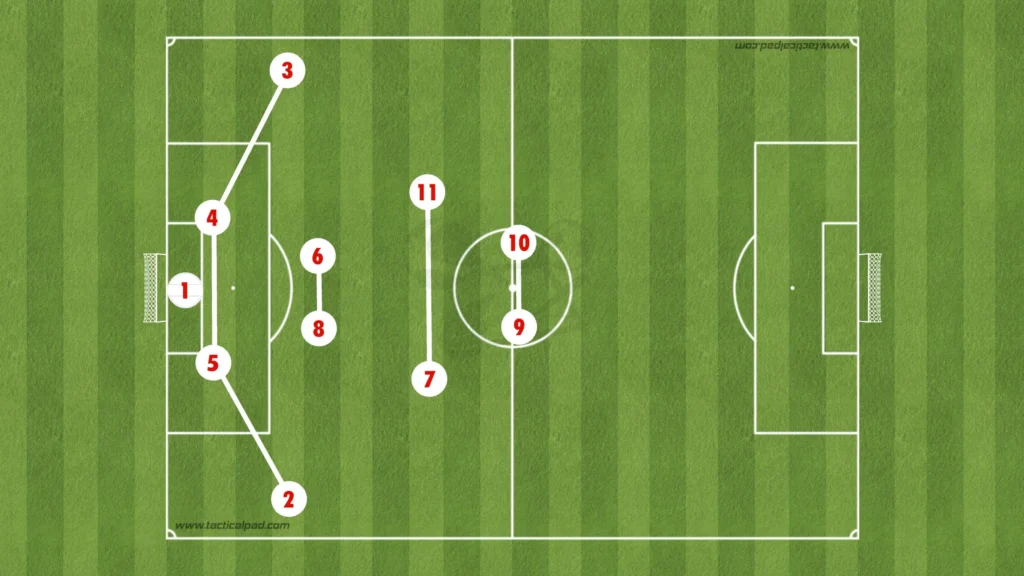
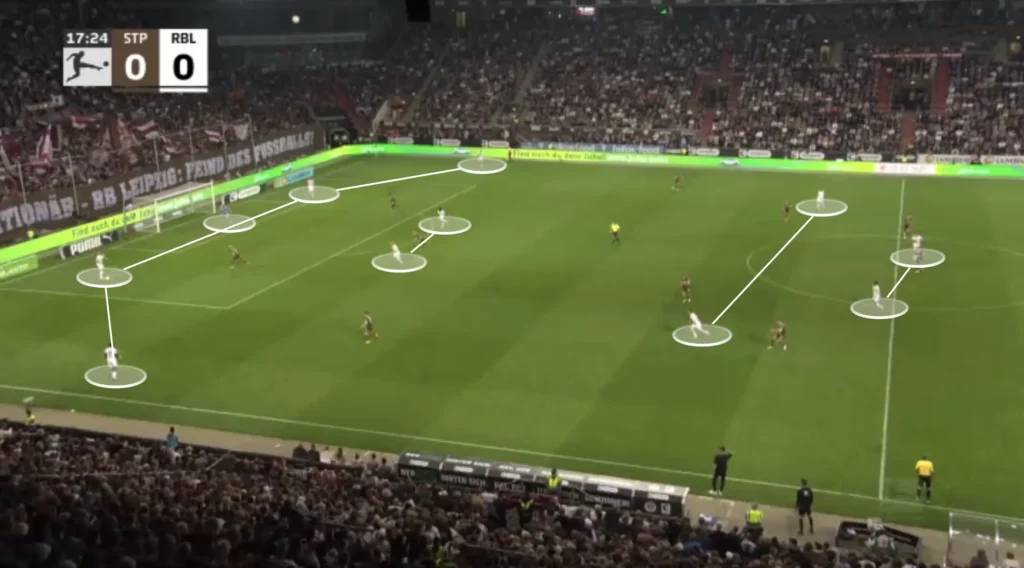
The seven building players will work together to beat the initial press and the four attackers will cooperate to create goalscoring opportunities. Rose mainly wants to beat the press by finding an attacking midfielder in the space between the opposition’s defense and midfield, who can bounce the ball to a holding midfielder, who then can progress the ball forward.
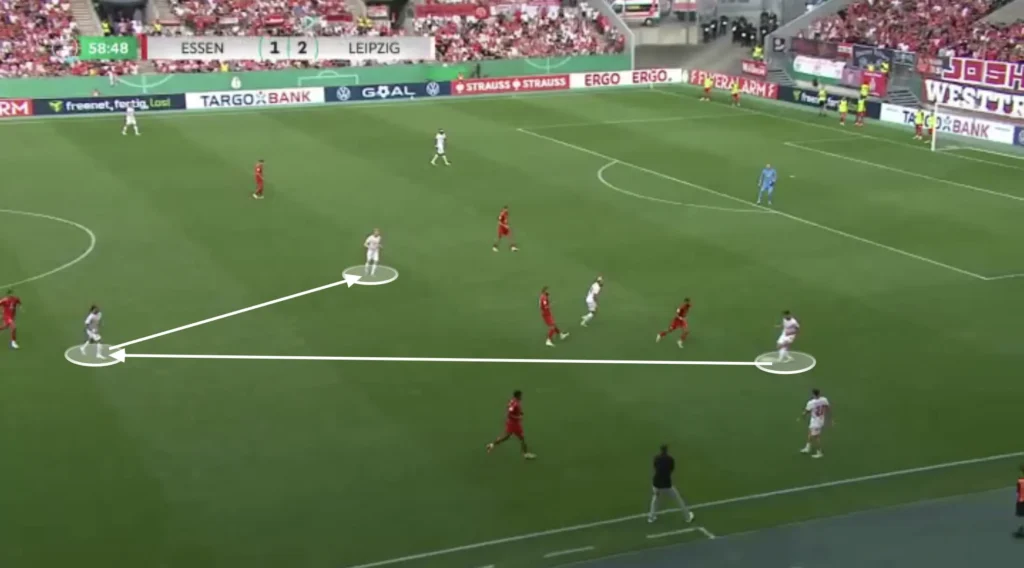
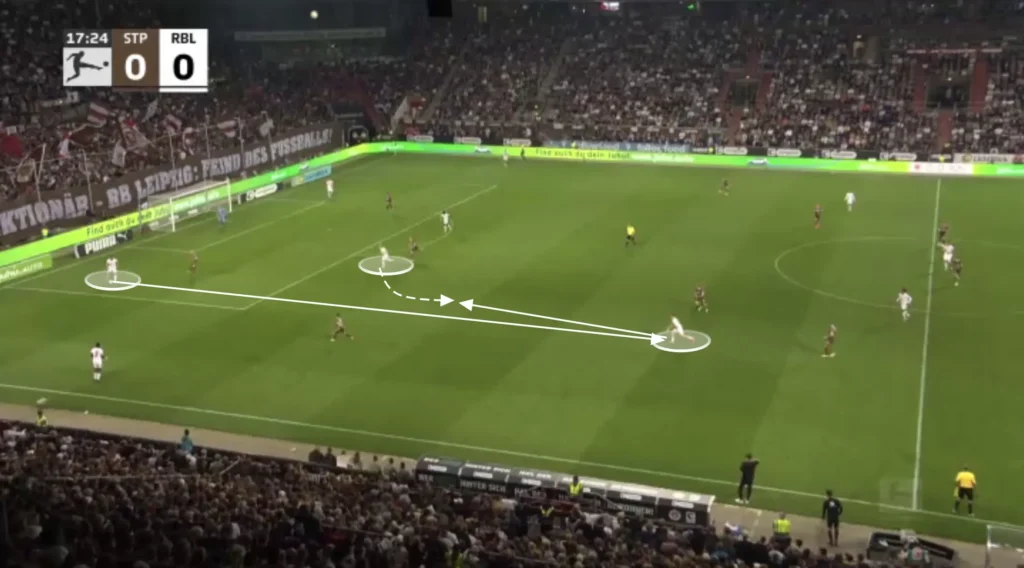
Leipzig will also get the ball to the holding midfielder by first playing it to the fullback, who then passes it to the holding midfielder.
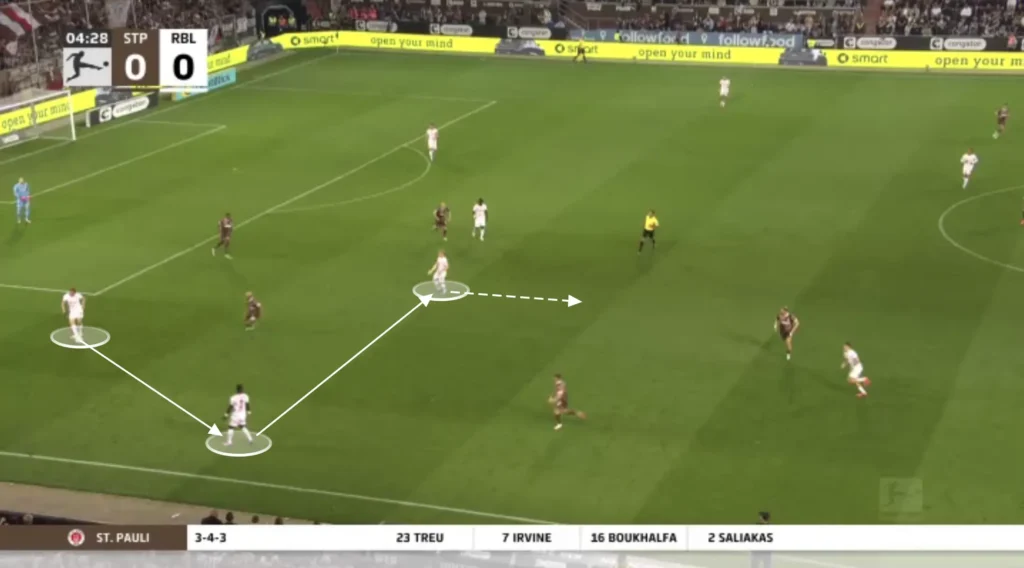
When Leipzig beat the press, the attackers will immediately make runs in behind, looking to quickly exploit the holes in the opposition’s backline.
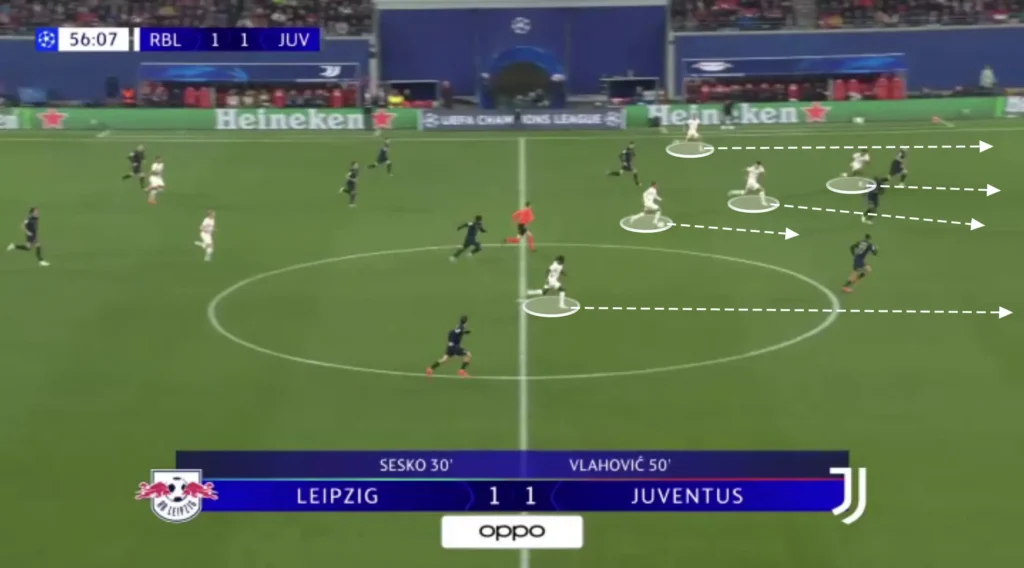
The Leipzig players are also not afraid to be more direct in the low build-up. If the opposition comes up and presses hard, the goalkeeper will find an early longer ball up to the four Lepizg attackers. The Leipzig attackers have good individual quality and will often win these battles to create goalscoring opportunities.
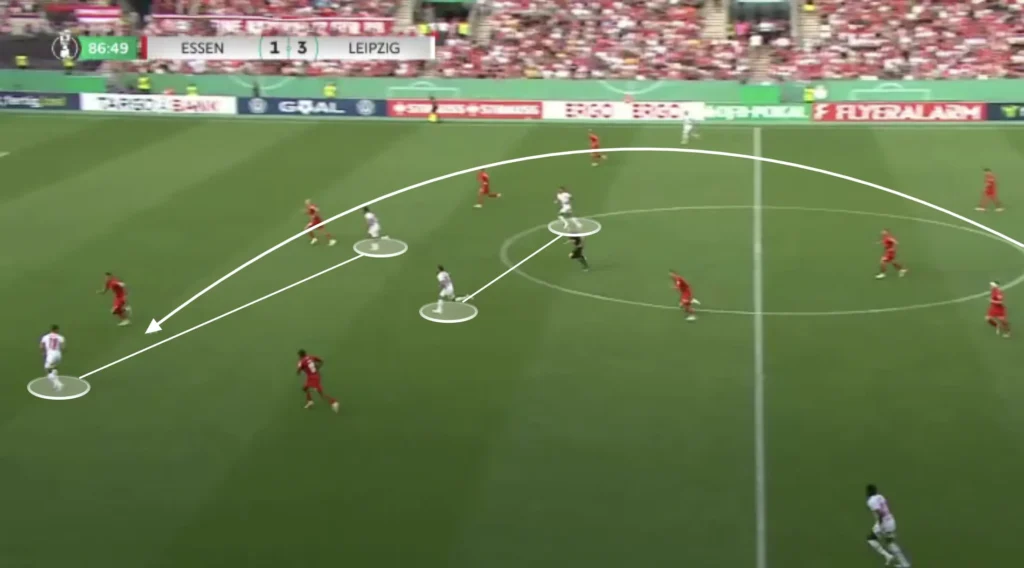
High Build-up
Rose’s Leipzig uses the 1-4-2-2-2 formation in the high build-up as well.
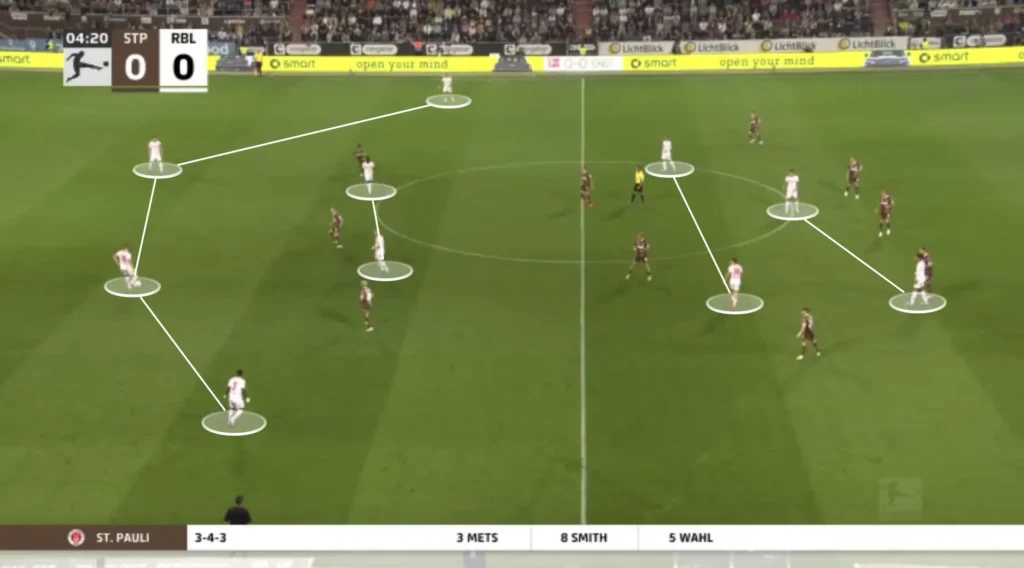
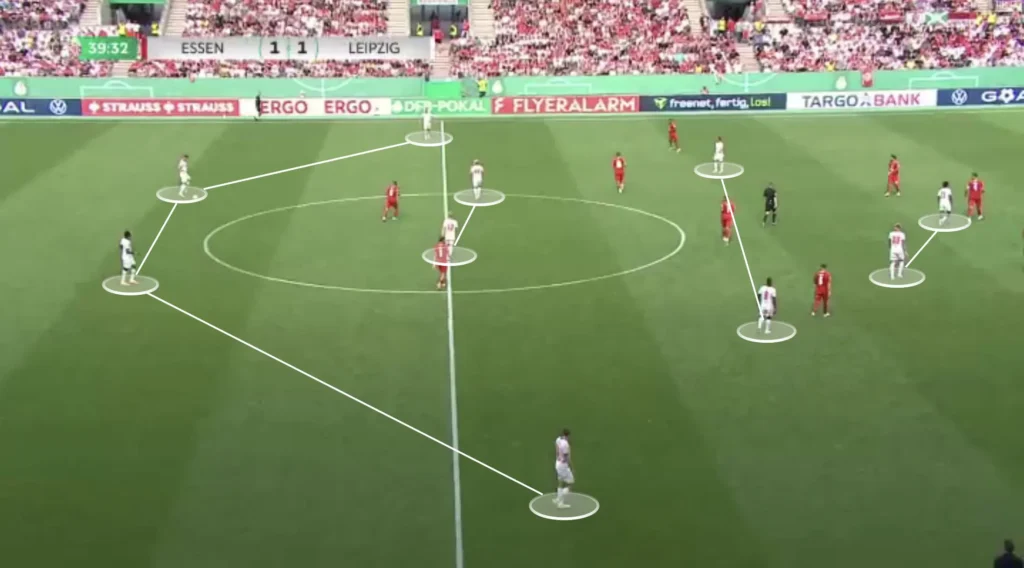
In the 1-4-2-2-2 formation, the fullbacks play a crucial role in providing width and supporting the attack by pushing up the field. As the two holding midfielders, two attacking midfielders, and two strikers often operate centrally, the fullbacks are tasked with advancing along the flanks to stretch the opposition’s defense. The Leipzig fullbacks always make runs up the pitch into the spaces outside the opposition defense to receive through-balls from the midfield or backline. They will have enough time and space to take the ball forward and cross it into the Leipzig attackers in the box.

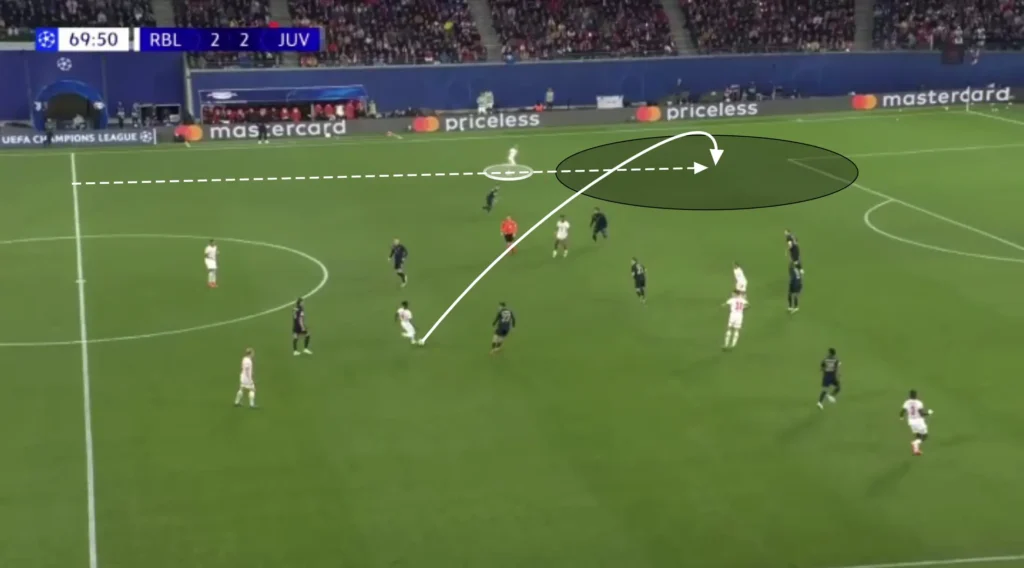
Numerical Advantages in the Middle
In the 1-4-2-2-2 formation, Leipzig will have eight players in the center and only two out wide.
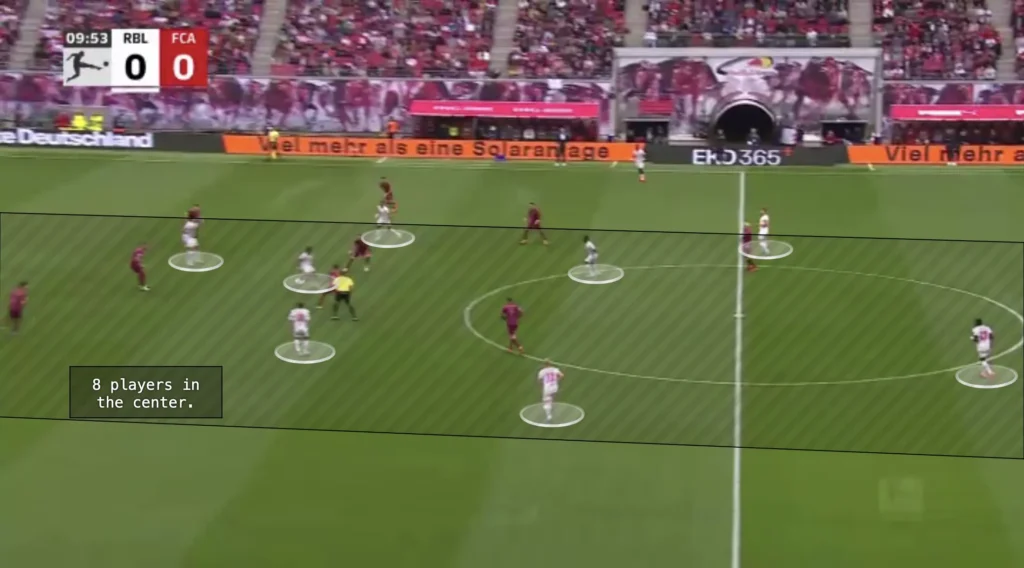
Having only the two fullbacks out wide and the rest of the players in the middle creates more options in the center and less space between the players. Rose likes this because he prioritizes playing through the middle. He needs one player out wide to pull the opposition apart while the rest create numerical advantages in the midfield areas. When a team outnumbers the opposition in the midfield, it can more easily retain the ball, exploit spaces, and progress the ball through the center. Leipzig will often progress the ball through quick central passes between the midfielders, beating the opposition’s press and exploiting gaps in the defense. At the same time, having many players centrally builds good conditions in defensive transitions since it allows more players to counterpress when they lose the ball.
Another purpose for keeping many players in the middle is to shorten the distance between them. This shortens the length of the passes, which naturally shortens the time between passes. This means the opposition players will have less time to push up and press, giving the Leipzig players more time and control.
Fluidity
The Leipzig players constantly rotate during the build-up. The team adopts a dynamic approach, shifting between formations to create numerical advantages and exploit spaces. Marco Rose’s focus is always to get the players into their best positions, where they can make the most out of their individual skills. He emphasizes versatility, with players interchanging positions seamlessly to maintain possession and disrupt the opposition’s defensive structure. This flexibility creates numerical superiorities in different areas, allowing Leipzig to bypass the opposition’s press while maintaining control.
Their most common rotation is to drop one of the holding midfielders into the backline. This shift creates a back three, allowing them to maintain defensive stability while gaining more control in possession.
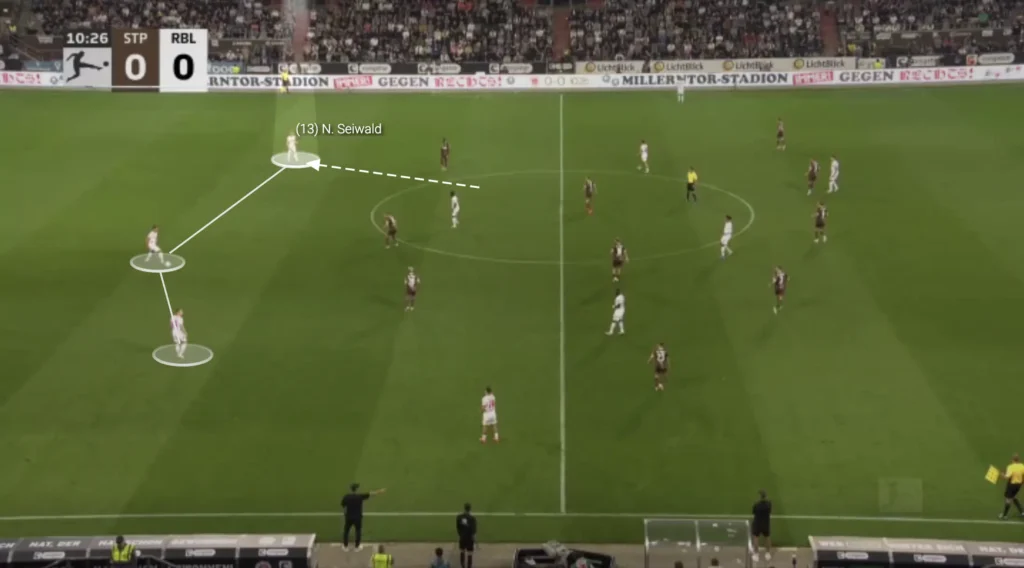
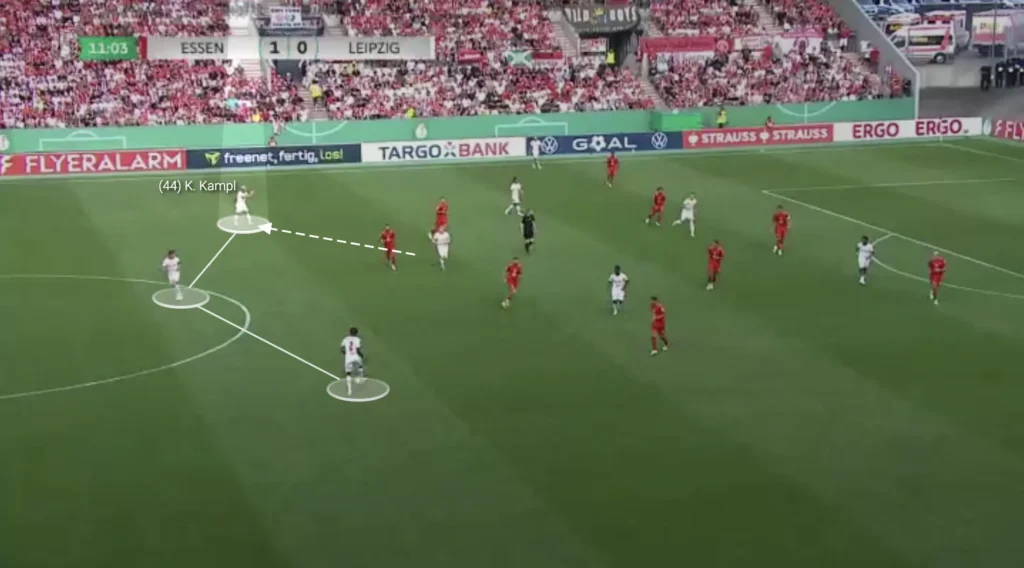
By doing this, Leipzig not only widen the field but also open up different angles for passing, making it easier to beat the opposition’s press. This tactical adjustment gives them more options in progressing the ball up the field and disrupts the opponent’s pressing structure, helping them maintain fluidity in their play.
Finding the Pockets
Rose’s players always try to find the attacking midfielders in the pockets. These “pockets” refer to the spaces between the opposition’s defensive and midfield lines, where the attacking midfielders can receive the ball in more advanced positions.
By positioning themselves intelligently in these pockets, the attacking midfielders can turn quickly and face the opposition’s goal, creating opportunities for through balls, driving runs, or direct shots. This positioning forces the opposition to make difficult decisions. If an opposition defender steps up and closes down the attacking midfielder, he potentially leaves space behind. If he stays back, he allows the midfielder time on the ball. The Leipzig defenders and holding midfielders will look for straight passes, breaking the opposition lines and finding the attacking midfielders who can turn and drive at the defense.
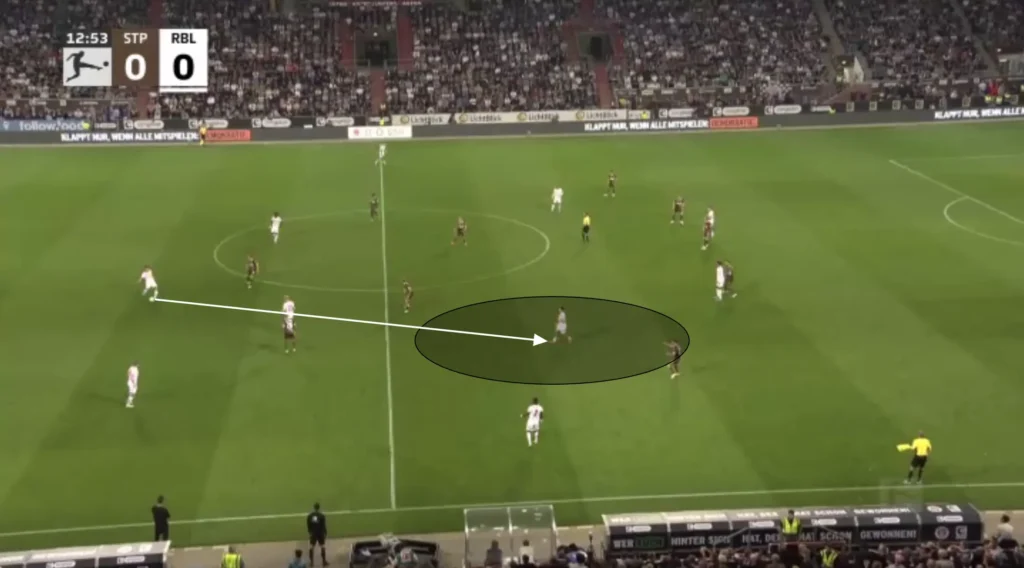
Leipzig will also use third-man combinations involving the striker to find players in these spaces. A defender or holding midfielder can play a straight pass to the striker, who can find an attacking midfielder in the pocket with a simple one-touch pass.
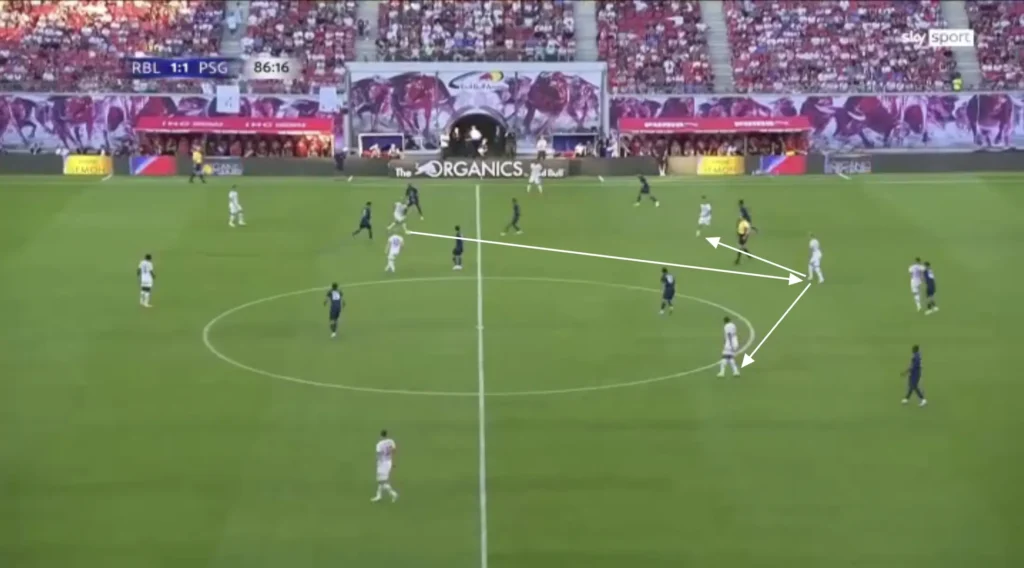
Finding these pockets is crucial for maintaining fluidity in attack and ensuring that the team can progress the ball effectively through the middle of the pitch.
Balls in Behind
The Leipzig strikers consistently make aggressive runs in behind the opposition defense whenever the Leipzig defenders or central midfielders have the ball. This movement is a key aspect of their offensive strategy, designed to stretch the defensive line and create space. As Leipzig advances the ball, the forwards will run in behind the opposition backline, exploiting gaps between defenders and allowing themselves to receive well-placed through-balls. The coordination between the defenders and attackers makes Leipzig’s offense unpredictable and difficult to defend against.
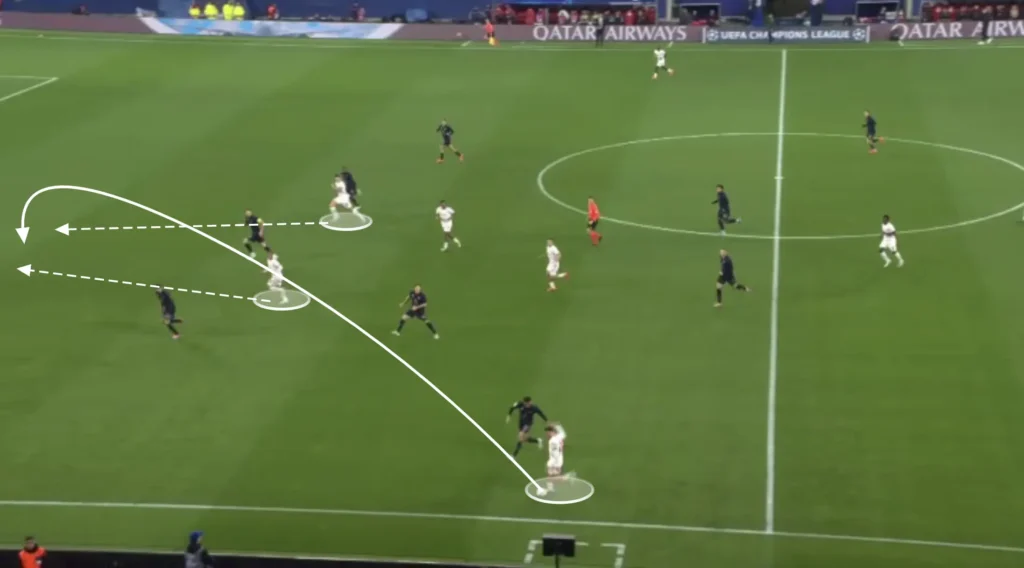
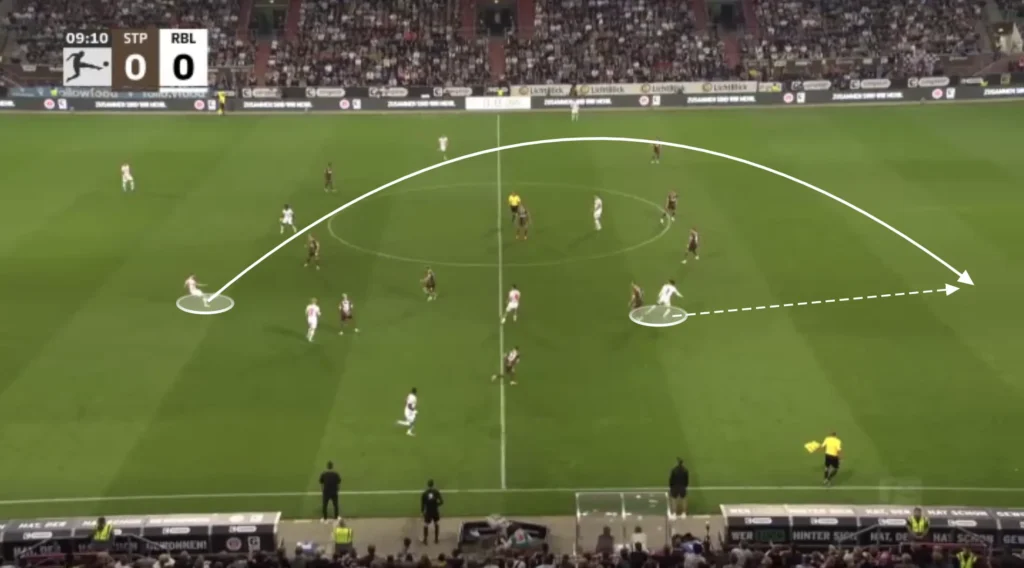
Additionally, this constant threat prevents the opposition from playing with a high backline and closing the space between the lines. Instead, they have to drop the backline and protect the space in behind. This opens the space in front of the backline for the Leipzig midfielders to exploit.
Counter-Movements
The Leipzig forwards will also use counter-movements to make it even more difficult for the opposition defenders. When one striker makes the run in behind, the other one will often drop. This forces the opposition center-backs to make a decision. If they step up on the dropping striker, the space behind them opens up, allowing Leipzig to play a through-ball to the striker, making a run in behind. However, if they stay in the backline to cover the run, the ball can be played to the dropping striker, who can turn and attack the defense.
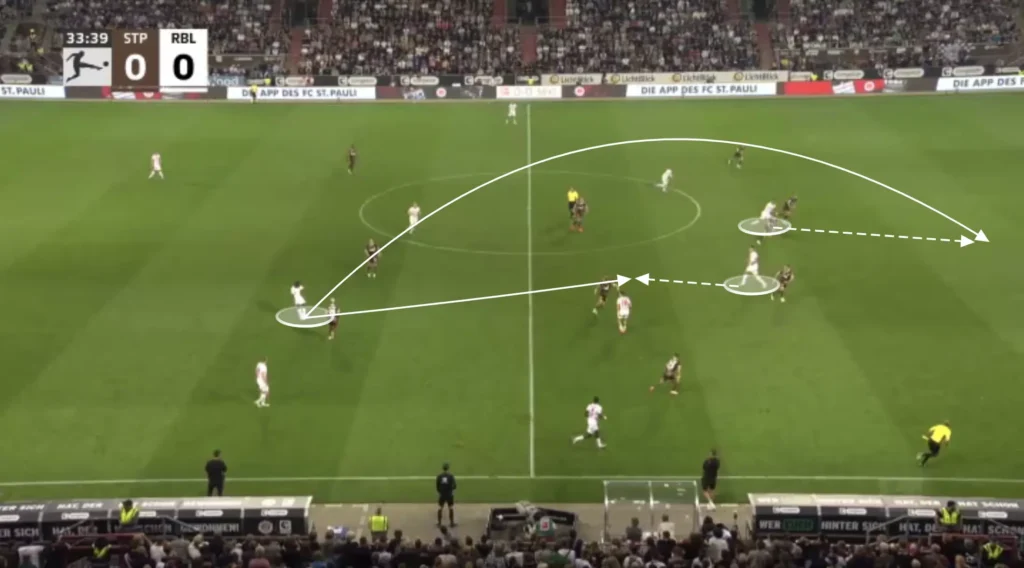
Final Third
Overlaps
Leipzig have effectively used overlaps as a key tactic to create goal-scoring opportunities under Marco Rose. This involves the fullbacks making forward runs to get around the attackers, providing an extra attacking option on the flanks. By doing so, they can create a 2v1 situation with another Leipzig attacker against the opposition fullback, which could be used to beat the fullback and create crossing opportunities.
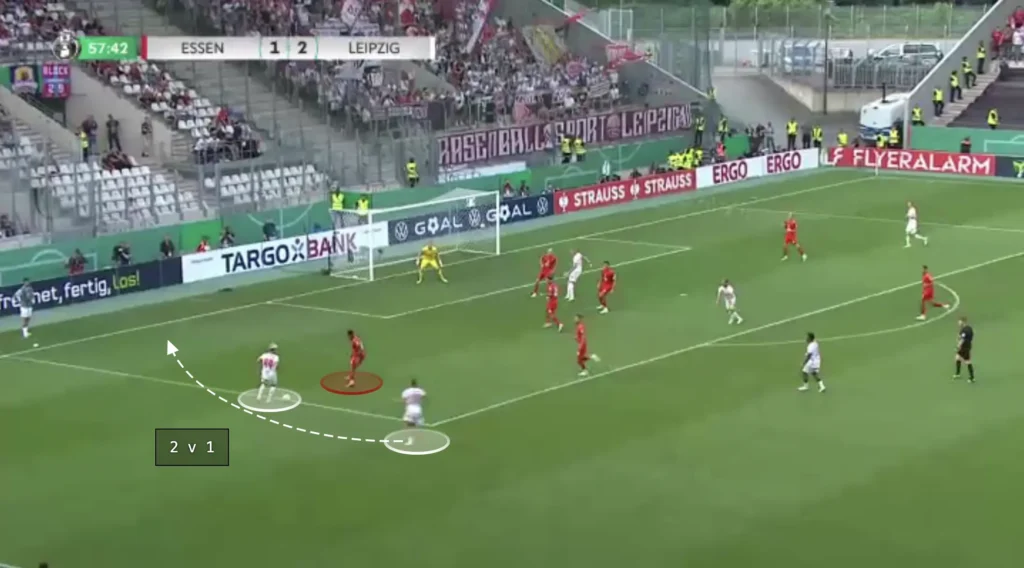
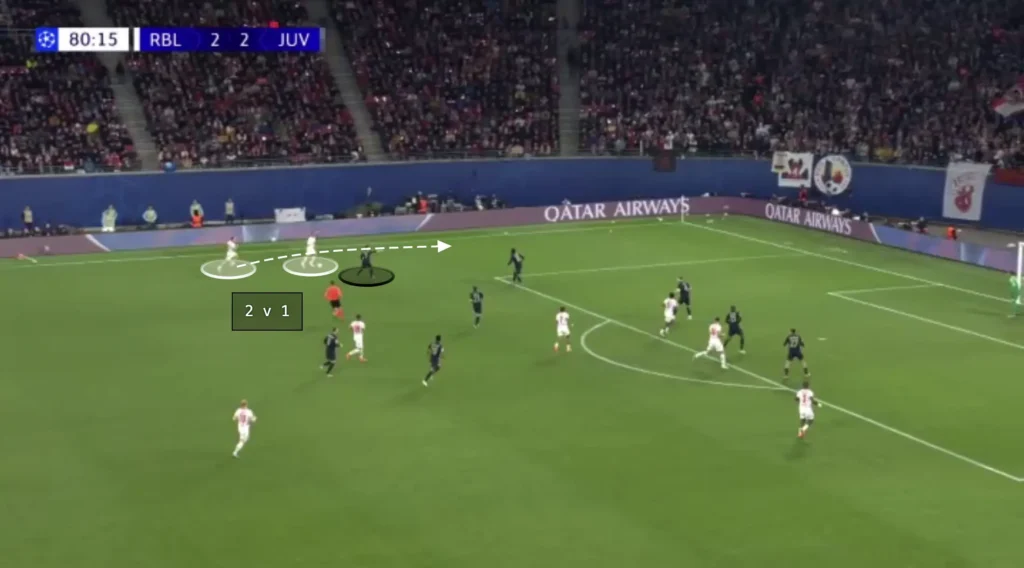
Leipzig’s attacking midfielders often initiate the play by dropping out into the wide areas and attracting the opposition fullback. This leaves space for an overlapping fullback to exploit. The overlap forces the defending fullback to make difficult decisions—either stick with the attacking midfielder or follow the overlapping run. If the opposition fullback drops to cover the overlapping run, the attacking midfielder could cut inside and take a shot or combine with another midfielder. If the fullback covers the center, the ball can easily be played to the overlapping player, creating a crossing opportunity.
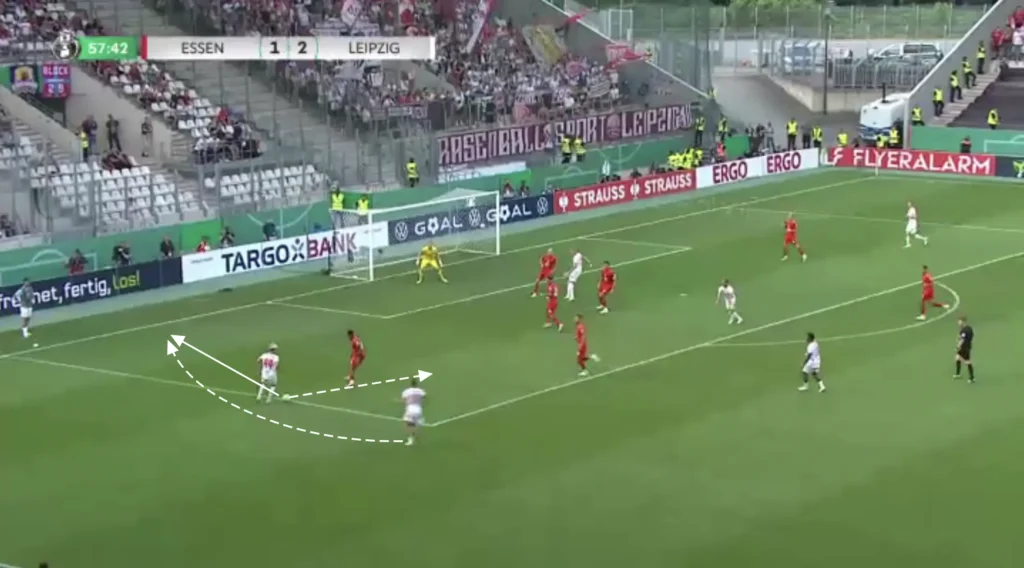
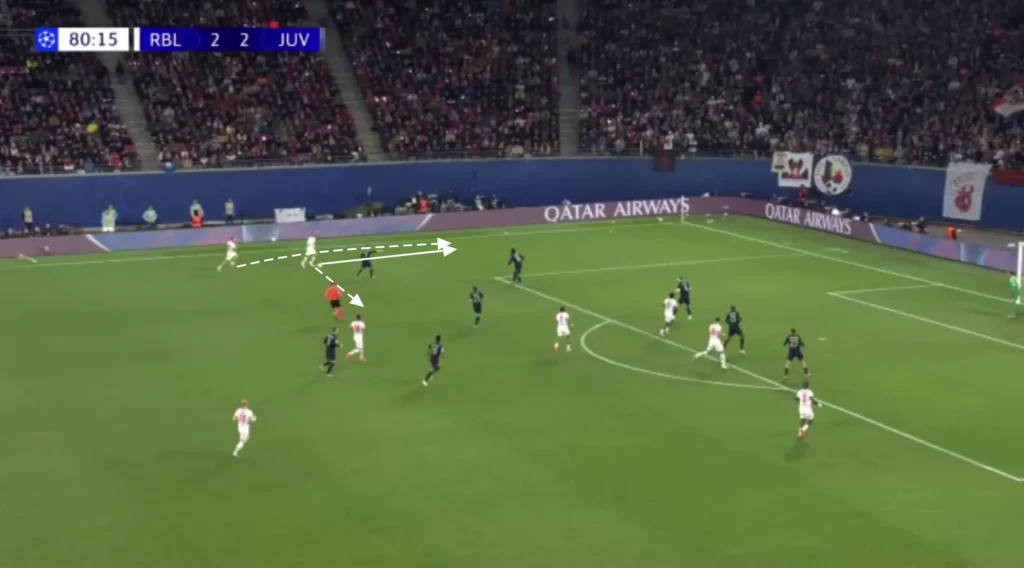
When executed well, this tactic allows Leipzig to overload the wide areas, often pulling defenders out of position and creating space in the box. The fullback then has the option to deliver a cross or cut-back, aiming for the Leipzig attackers in the box, who thrive on these deliveries. This use of overlaps has been a crucial element of Marco Rose’s attacking strategy, adding variety to Leipzig’s offensive play and increasing their threat in the final third.
Many Players in the Box
The strikers and midfielders always look to make runs into the box when the ball is in the final third, often getting four or five players into these areas to create overloads. The numerical advantages in the box increase the chances of connecting with the cross, as more players present multiple targets for the crosser, making it harder for defenders to mark everyone effectively. Additionally, having multiple players in the box provides options for different types of finishes, whether it’s a header, volley, or a quick tap-in. It also allows for better positioning to react to second balls or rebounds, increasing the likelihood of capitalizing on any defensive errors.
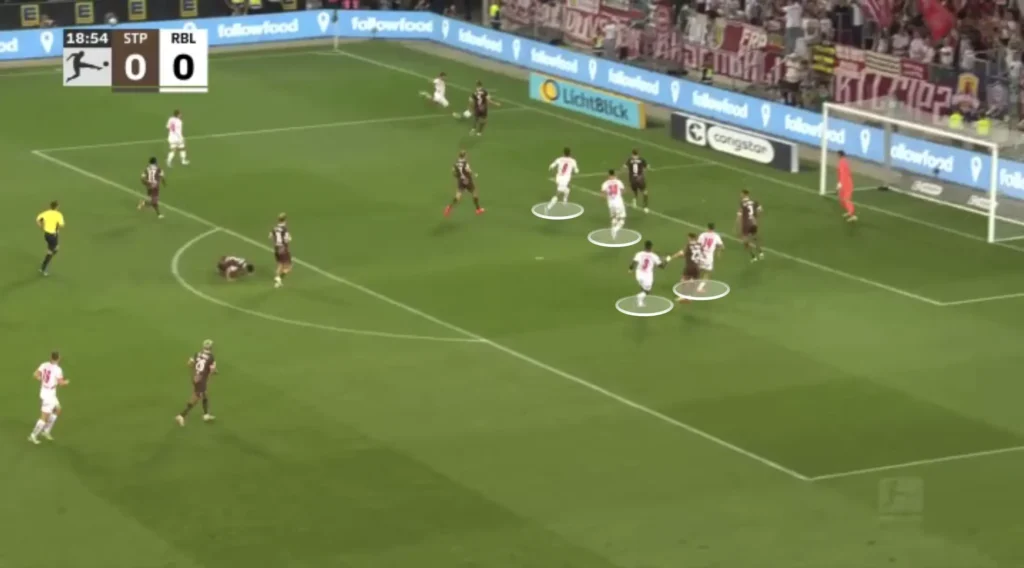
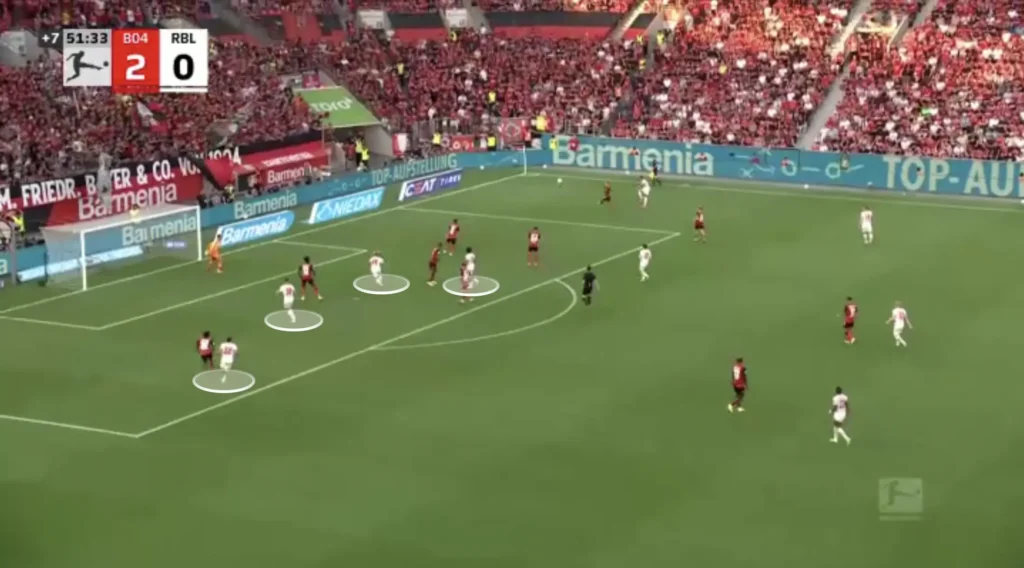
In Leipzig’s attacking system, the attacking fullbacks score many goals from crosses at the back post. The opposition fullback will often be preoccupied with a Leipzig attacker, which leaves massive space at the back post for the fullback to attack. The fullback can be found directly or indirectly if no one else connects with the cross.
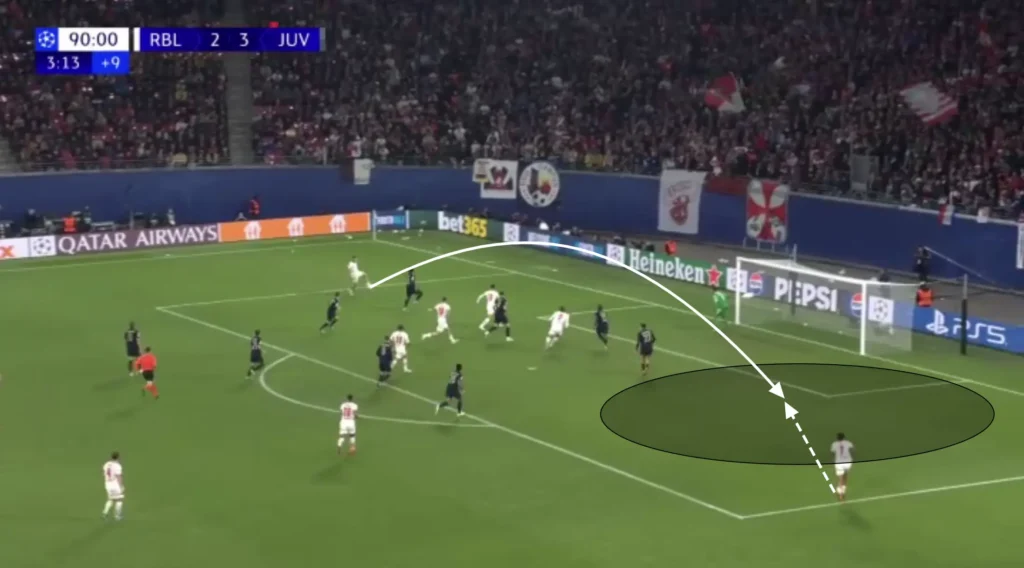
Rose also positions many players outside the box, ready for the second balls and cut-backs. Leipzig will often create crossing opportunities, which pushes down the opposition’s defense and opens the space in front of the opposition’s backline. The holding midfielders can collect any loose balls or be found directly in these spaces with cut-backs, and from there, they can shoot or combine with an attacker to create goalscoring opportunities.
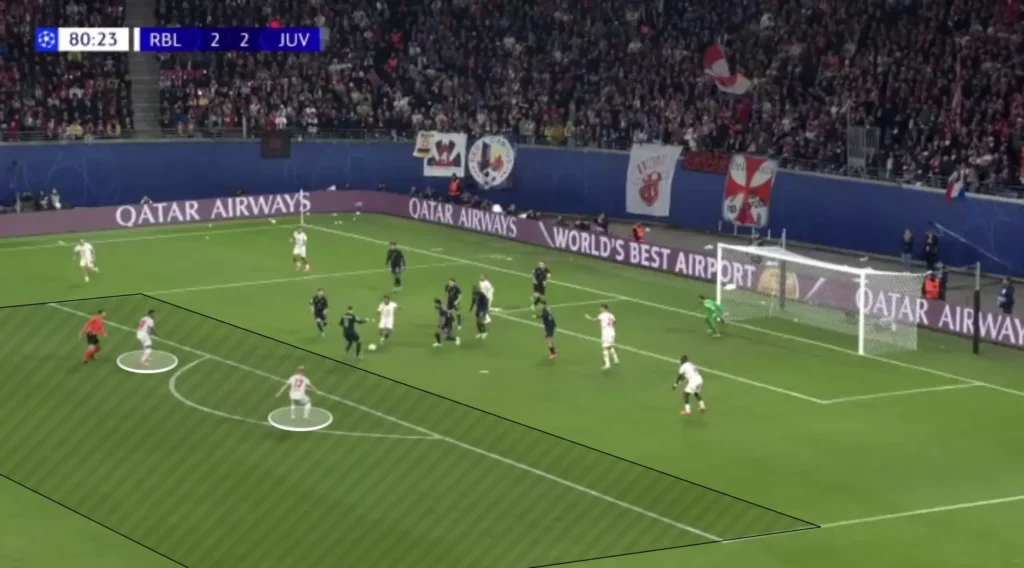
Defending
Low Press
Leipzig’s base formation when defending is the 1-4-4-2 formation. They look to set up in a mid-block, always trying to close the center and force the opposition out wide. Defending in the 1-4-4-2 formation is all about balance, compactness, and discipline. The team defends in two compact lines of four, with the forwards positioned ahead of the midfield. The two forwards play a crucial role, not only as the first line of defense but also in initiating the team’s pressing strategy. Rose wants his team to stay compact without dropping too low, preferably closing the space between the midfield and backline.
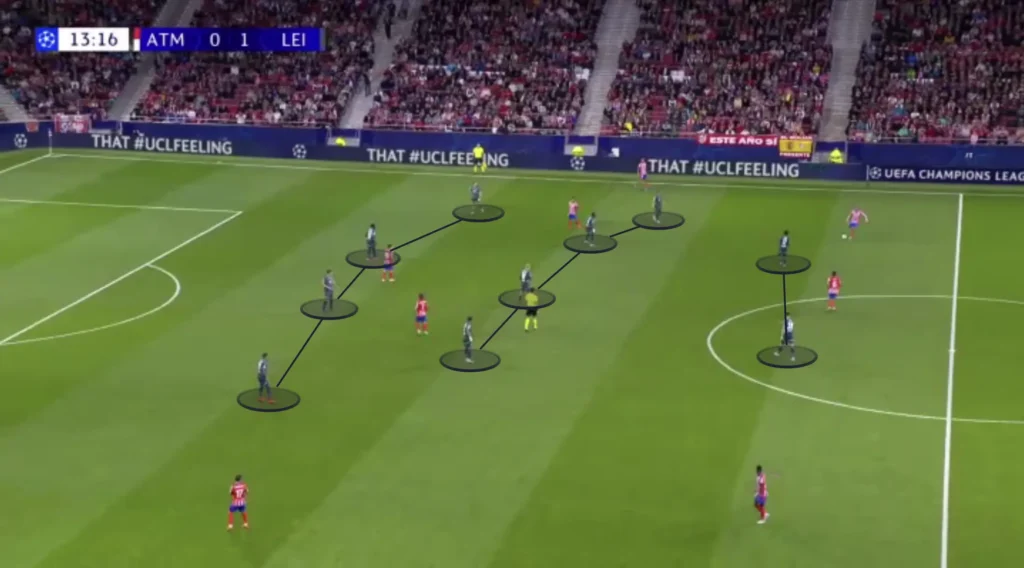
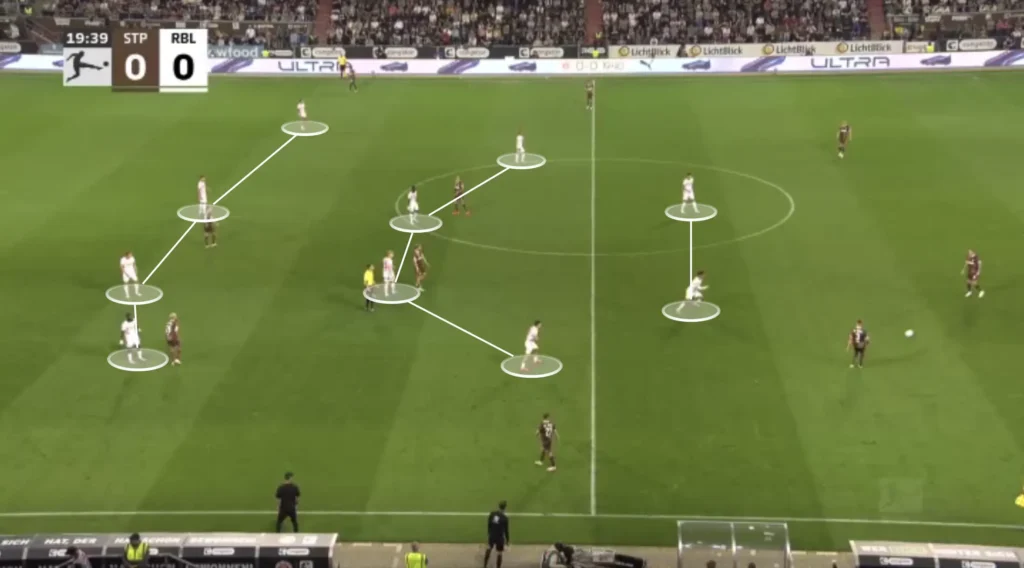
When Leipzig defend against teams who build in a back three, the wingers often push up to put pressure on the opposition’s outside center-backs. When the wingers press the center-backs, they close the passing lanes to the opposition fullbacks/wingbacks. This forces the opposition center-backs into the middle, where Rose wants to win the ball with the strikers, who block off all of the center-back’s passing options. One of the strikers will drop back to cover passes into the midfield while the other one pushes up to close the pass to the central center-back.
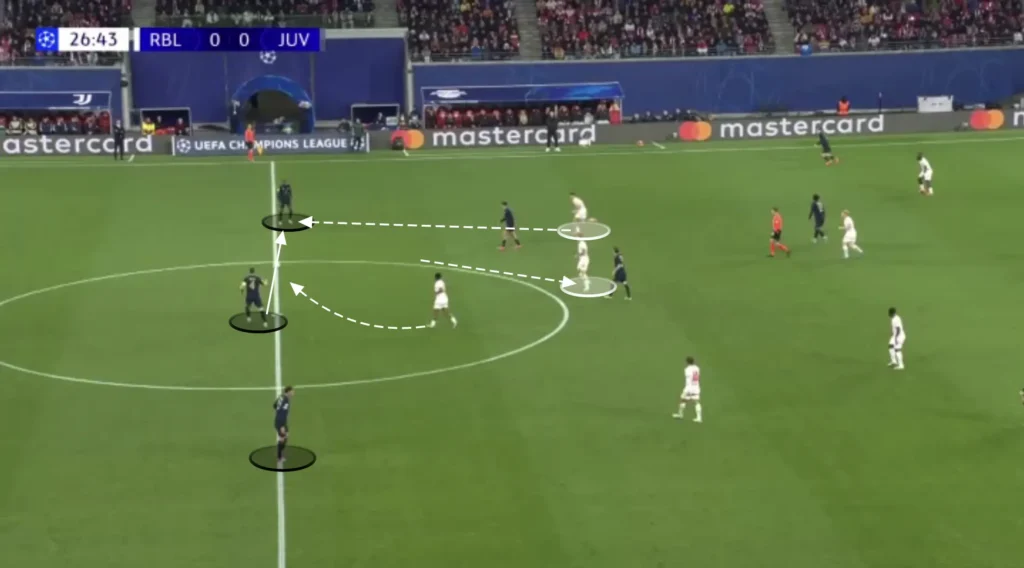
Squeezing the Pitch
Marco Rose also wants his team to squeeze the pitch when defending. This means constantly pushing the team up as much as possible. Every time the opponent plays a slow, sideways pass or a back pass, Leipzig’s first line of pressure pushes up, with the rest of the team following to stay compact. When the next pass comes, they push up even more, forcing the opponent back even more. They do this because it pushes the opponent further away from Leipzig’s goal, making it harder to create chances.
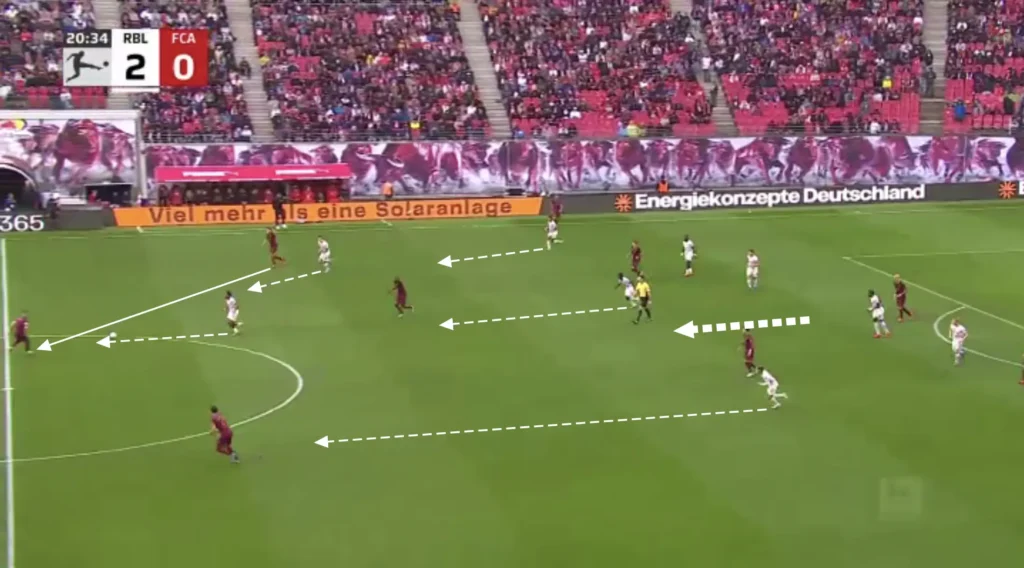
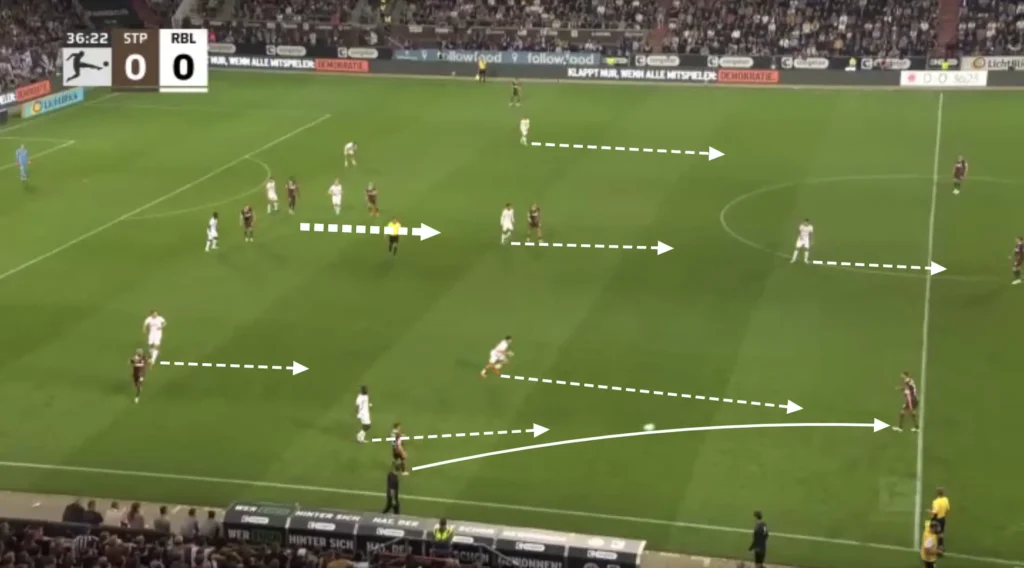
High Press
Leipzig always look to press the opposition high up the pitch. Their pressing structure will depend on the opposition, but they primarily press in a 1-4-1-3-2 formation.
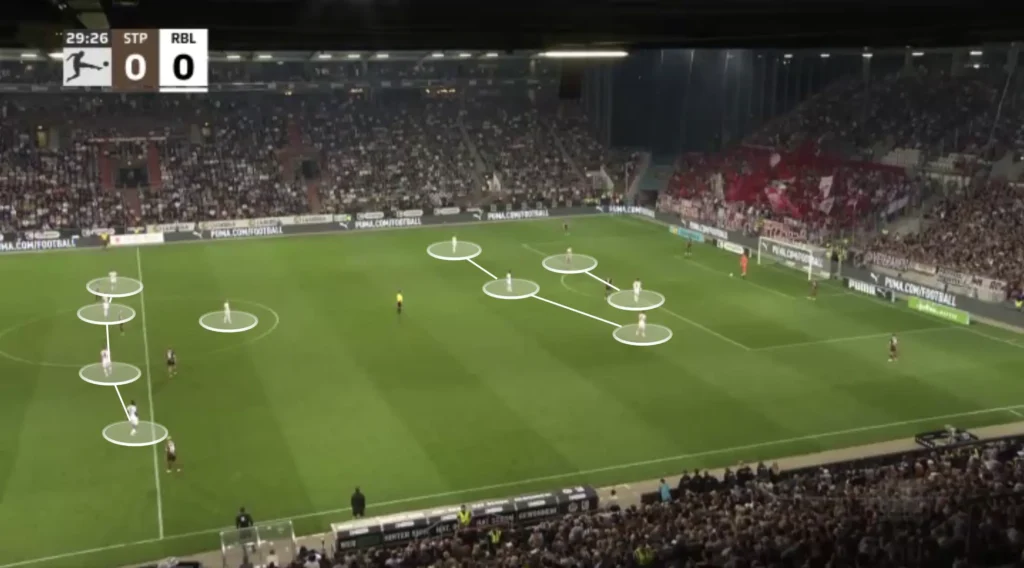
The strikers will try to close off one opposition center-back by making angled pressing runs, forcing the opposition to one side. The rest of the players will shift across and try to win the ball by using the touchline as an extra defender.
Leipzig will be extremely aggressive and intensely press to win the ball when it gets played out to one of the opposition fullbacks. The ball-side wide midfielder pushes up on the ball-side opposition fullback, with the rest of the midfield shifting across to close down any passing options. The ball-side striker will try to stop the opposition from switching sides by pushing up on the ball-side center-back, while the far-side striker comes over, ready to press the goalkeeper.
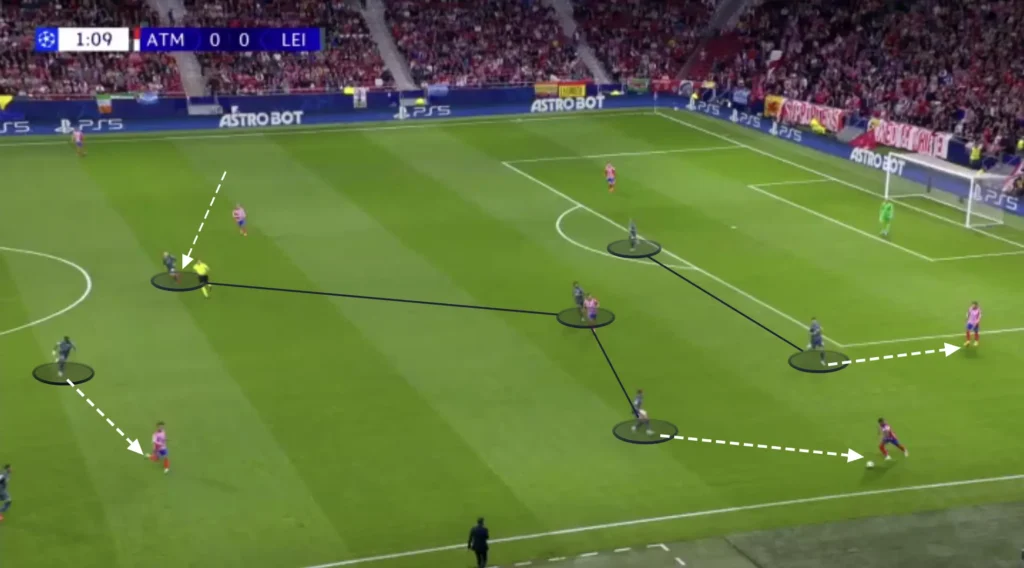
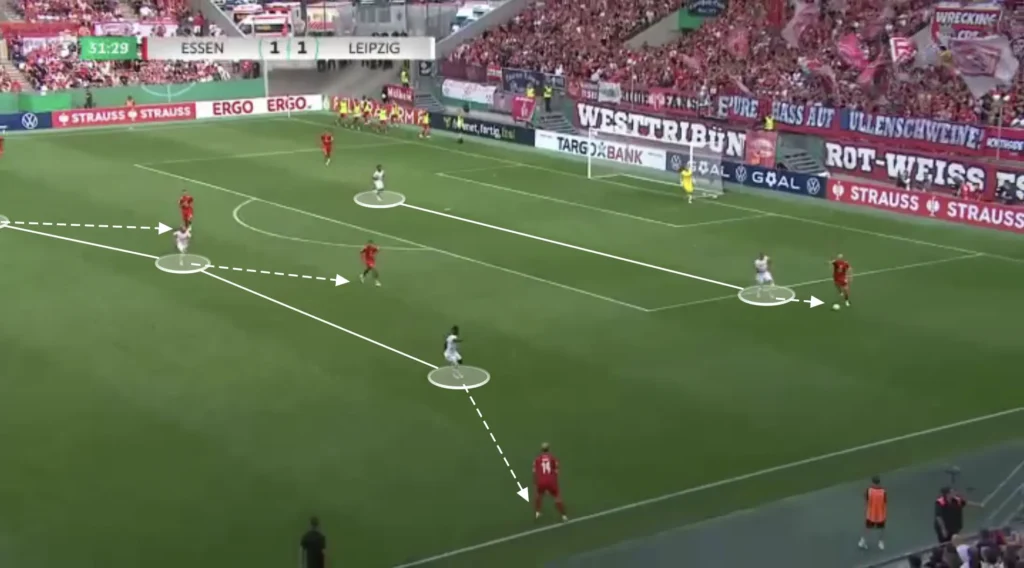
This system allows Leipzig to press the opposition high up the pitch while having a numerical advantage against the opposition attackers, which gives them more control when defending long balls.
Transitions
Defensive Transitions
Positioning many players centrally, creating a numerical advantage in the midfield, creates good conditions in defensive transitions. Many players close to the ball after losing possession means that many players can work towards regaining possession. Rose’s players are also very aggressive in the first seconds after losing the ball. The four or five players closest will immediately jump on the opposition player with the ball and close the distance to cut off any passing lanes. This approach disrupts the opponent’s transition from defense to attack, forcing errors and creating opportunities to regain control in dangerous areas.
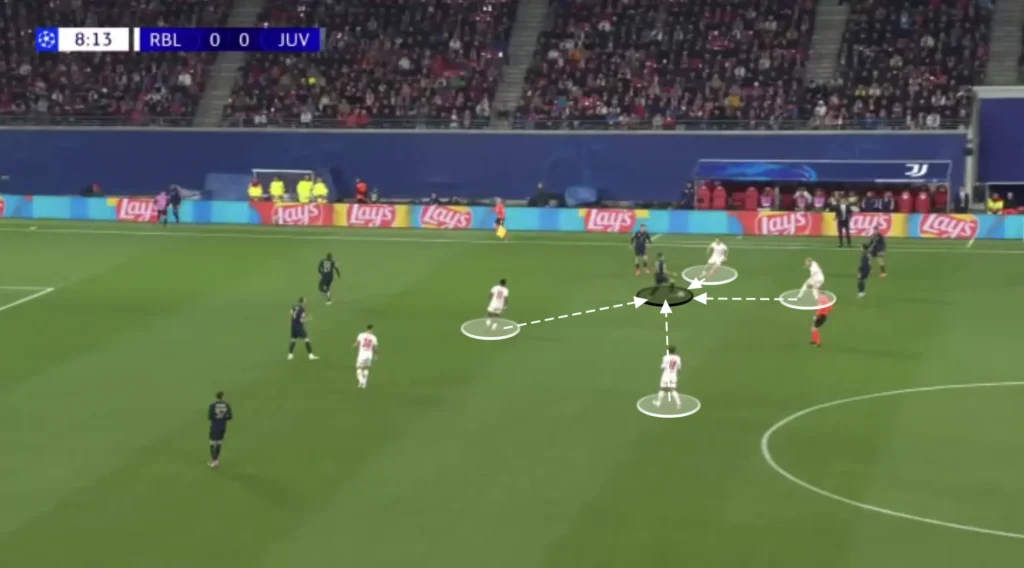
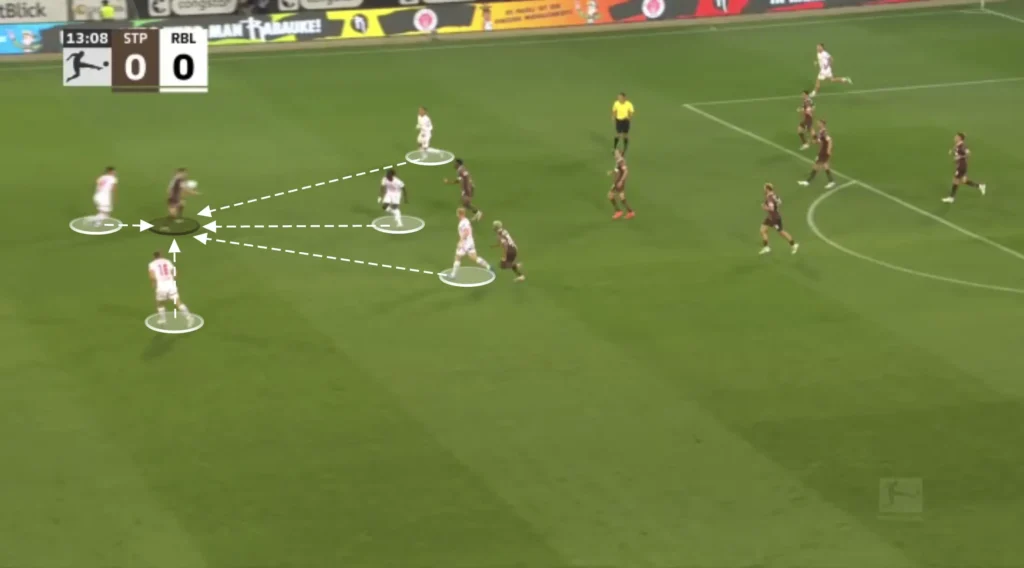
Counterpressing like this keeps Leipzig on the front foot, allowing them to dominate possession and create more scoring opportunities. However, it requires exceptional fitness, tactical discipline, and teamwork.
Offensive Transitions
Marco Rose also wants his team to counterattack in their offensive transitions. When winning the ball, the team transitions quickly from defense to attack, utilizing the speed and movement of their forward players. Rose emphasizes vertical passes to exploit spaces left by the opposition, often targeting wide areas or gaps between defenders. Leipzig’s counterattacks are well-organized, with players making intelligent off-the-ball runs to create overloads and support the ball carrier. This quick, direct style catches opponents off guard, making Leipzig a dangerous team on the break.
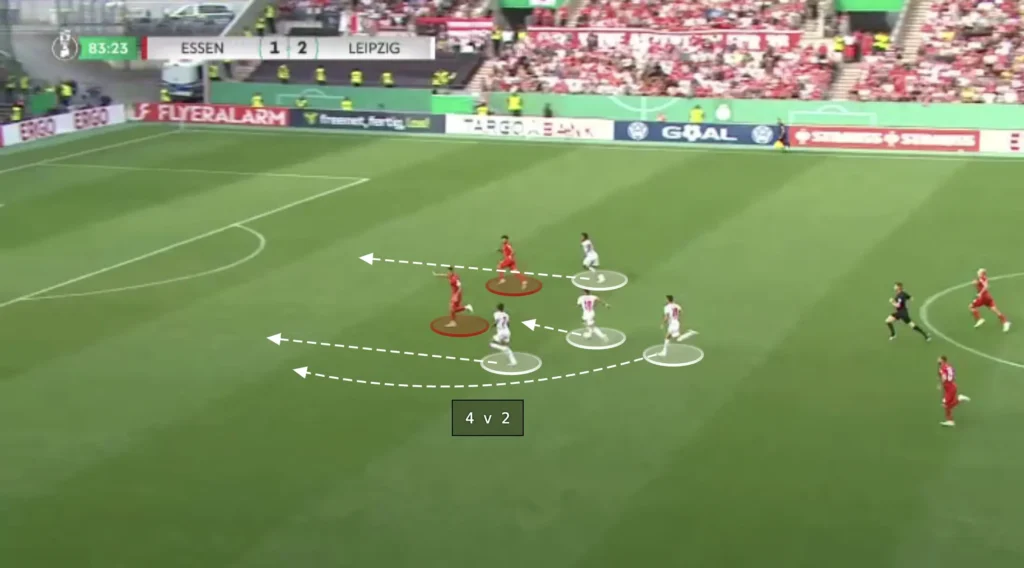
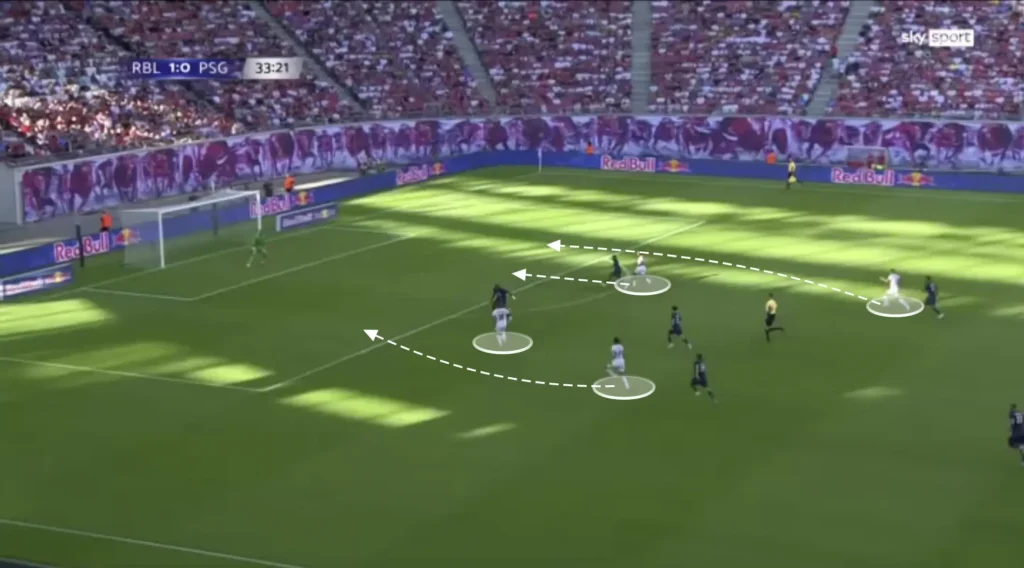
Additionally, the Leipzig players are great at finding open spaces in the counterattacks. Instead of playing the ball straight forward where opposition defenders may still be positioned, they play a diagonal pass, allowing the team to bypass pressure and shift the play into open areas. From these areas, the Leipzig attackers can take the ball forward and combine with each other to quickly get past the opposition and create a goalscoring opportunity.
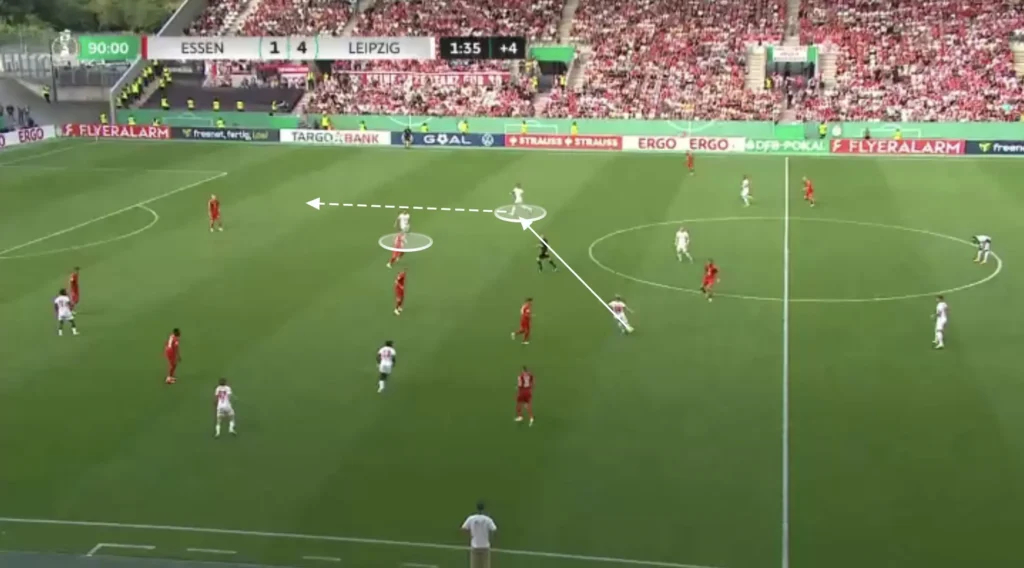
Leipzig’s aggressiveness also means they have many players high up when defending, which enables them to incorporate more players into the counterattacks.
Final Thoughts
In conclusion, Marco Rose’s tactical approach at RB Leipzig has brought a fresh, aggressive, and well-balanced identity to the team. His emphasis on high pressing, fluid attacking play, and defensive organization has transformed Leipzig into a dynamic and unpredictable force. By blending quick transitions with positional discipline, Rose has developed a system that maximizes the talents of his players while maintaining tactical flexibility.
As Leipzig continues to grow under his leadership, Rose’s tactics will be key to pushing the team further in both domestic and European competitions. His vision and strategic expertise make RB Leipzig a formidable contender, capable of adapting to different challenges while staying true to Rose’s attacking philosophy.
